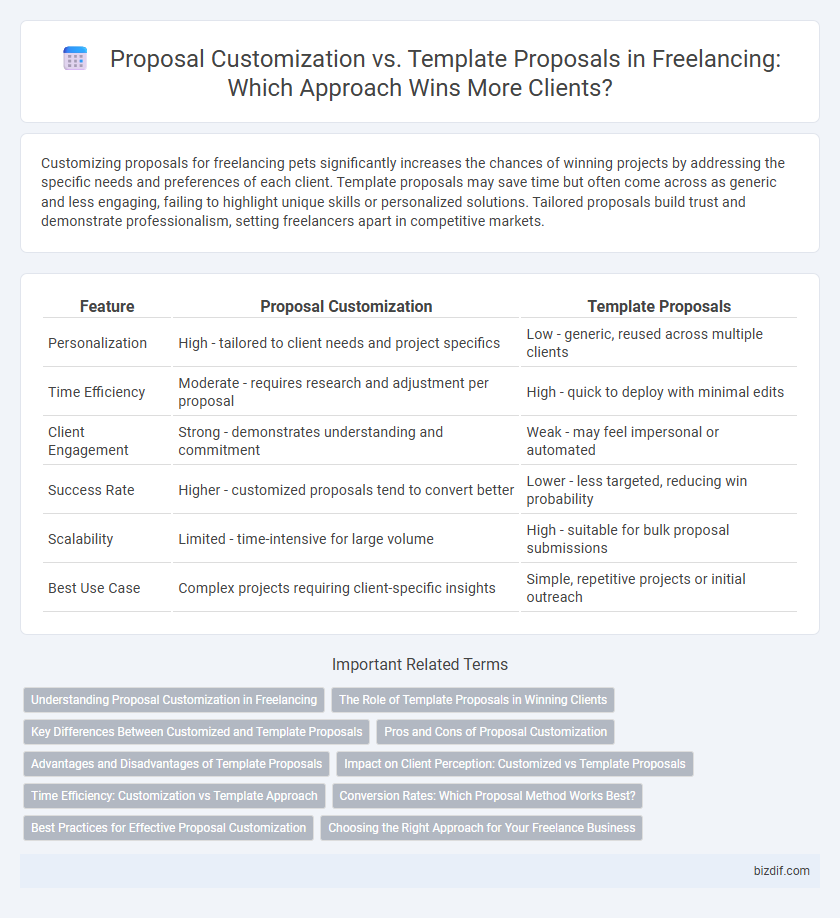Customizing proposals for freelancing pets significantly increases the chances of winning projects by addressing the specific needs and preferences of each client. Template proposals may save time but often come across as generic and less engaging, failing to highlight unique skills or personalized solutions. Tailored proposals build trust and demonstrate professionalism, setting freelancers apart in competitive markets.
Table of Comparison
| Feature | Proposal Customization | Template Proposals |
|---|---|---|
| Personalization | High - tailored to client needs and project specifics | Low - generic, reused across multiple clients |
| Time Efficiency | Moderate - requires research and adjustment per proposal | High - quick to deploy with minimal edits |
| Client Engagement | Strong - demonstrates understanding and commitment | Weak - may feel impersonal or automated |
| Success Rate | Higher - customized proposals tend to convert better | Lower - less targeted, reducing win probability |
| Scalability | Limited - time-intensive for large volume | High - suitable for bulk proposal submissions |
| Best Use Case | Complex projects requiring client-specific insights | Simple, repetitive projects or initial outreach |
Understanding Proposal Customization in Freelancing
Proposal customization in freelancing significantly improves client engagement by tailoring each pitch to the specific project requirements and client preferences. Unlike generic template proposals, customized proposals address the unique challenges and objectives outlined in the job description, demonstrating the freelancer's attentiveness and expertise. This personalized approach increases the likelihood of winning contracts and building long-term client relationships.
The Role of Template Proposals in Winning Clients
Template proposals streamline the initial outreach process by providing consistent, professional frameworks that save time and ensure key project details are addressed. Customizing templates with client-specific information enhances relevance, demonstrating genuine interest and understanding of client needs. This strategic balance between templates and customization increases the likelihood of winning clients by combining efficiency with personalized engagement.
Key Differences Between Customized and Template Proposals
Customized proposals cater specifically to the client's unique project requirements, demonstrating a deep understanding of their goals, which significantly increases the chances of winning the contract. In contrast, template proposals offer a standardized and quicker solution but often lack personalization, making them less effective in competitive freelance markets. Personalizing key sections such as project scope, deliverables, and client benefits distinguishes customized proposals by highlighting relevance and attention to detail.
Pros and Cons of Proposal Customization
Proposal customization in freelancing enhances client engagement by addressing specific project needs, increasing the likelihood of winning contracts due to its personalized approach. However, it requires more time and effort compared to using template proposals, which may slow the application process when handling multiple bids. Customized proposals demonstrate professionalism and attention to detail but may reduce efficiency in high-volume proposal submissions.
Advantages and Disadvantages of Template Proposals
Template proposals streamline the freelancing application process by enabling quick submission to multiple clients, saving time and effort. However, they often lack personalization, which can reduce engagement and lower the chances of winning competitive projects. The generic nature of template proposals may fail to address specific client needs, diminishing their overall effectiveness in securing contracts.
Impact on Client Perception: Customized vs Template Proposals
Customized proposals demonstrate a freelancer's attention to a client's unique needs and project specifications, significantly enhancing client trust and engagement. Template proposals often appear generic and impersonal, which can lead to doubts about the freelancer's commitment and understanding of the project. Tailoring each proposal increases the likelihood of positive client perception, leading to higher response rates and successful project acquisition.
Time Efficiency: Customization vs Template Approach
Template proposals significantly reduce drafting time by providing a reusable structure, enabling freelancers to quickly adapt proposals for multiple clients without starting from scratch. Customization demands additional time as each proposal must be tailored to specific project requirements and client preferences, enhancing relevance and increasing the chances of winning contracts. Balancing the time efficiency of templates with the strategic advantage of personalized content is crucial for maximizing productivity and securing freelance opportunities.
Conversion Rates: Which Proposal Method Works Best?
Customizing freelance proposals significantly boosts conversion rates by addressing specific client needs and demonstrating genuine understanding of the project scope. Template proposals, while time-efficient, often result in lower engagement due to their generic nature and lack of personalization. Data from freelance platforms show customized proposals converting up to 30% higher than templates, proving tailored pitches are more effective in winning contracts.
Best Practices for Effective Proposal Customization
Effective proposal customization involves tailoring each freelance pitch to the client's specific project requirements, demonstrating a clear understanding of their needs and goals. Highlighting relevant skills, experience, and previous work aligned with the project increases credibility and engagement. Avoiding generic templates enhances the proposal's uniqueness, significantly boosting the chances of securing contracts in competitive freelancing markets.
Choosing the Right Approach for Your Freelance Business
Customizing proposals increases the likelihood of winning freelance projects by addressing specific client needs and demonstrating a clear understanding of their goals. While template proposals save time by providing a reusable structure, they often lack the personalized touch that builds trust and sets freelancers apart from competitors. Selecting the right approach involves balancing efficiency with personalization to maximize client engagement and project success.
Proposal Customization vs Template Proposals Infographic

 bizdif.com
bizdif.com